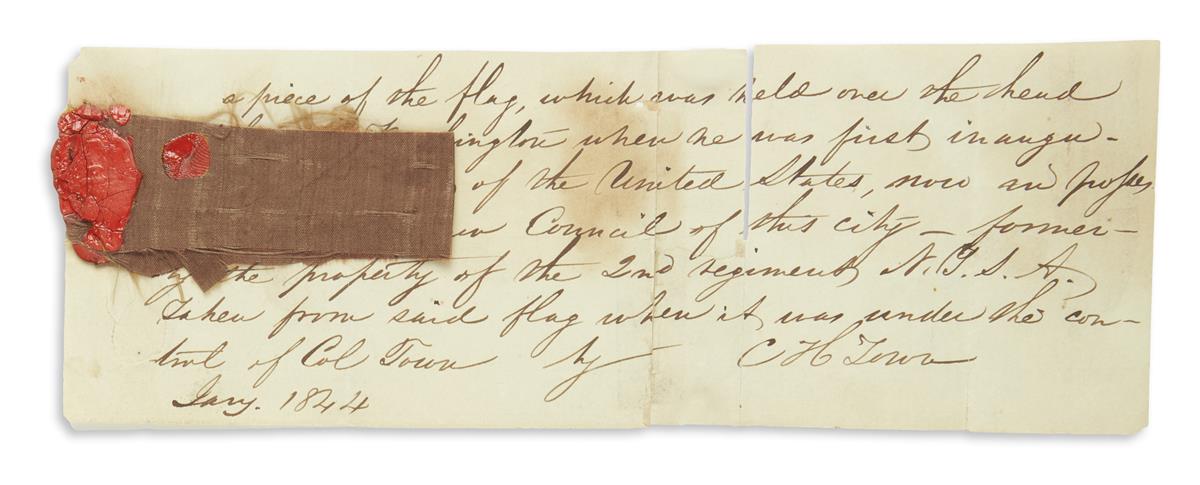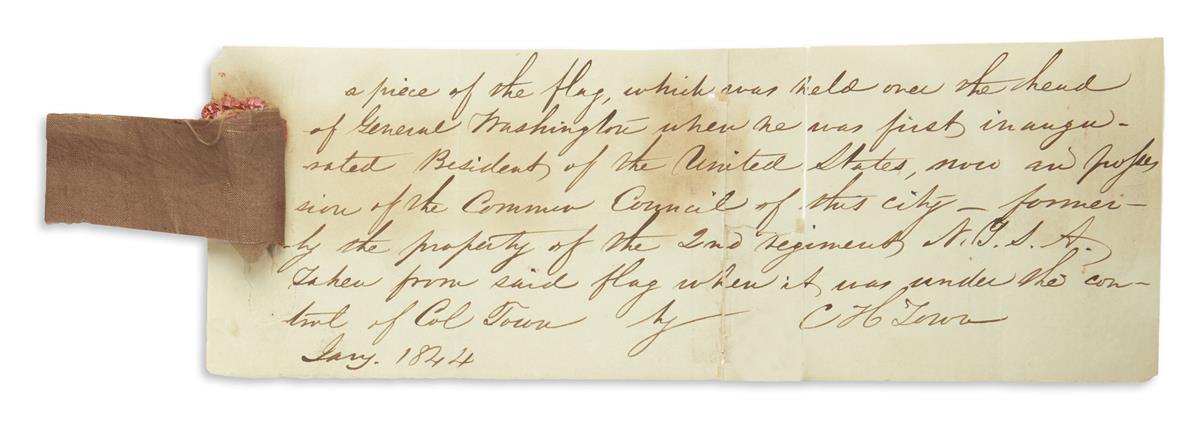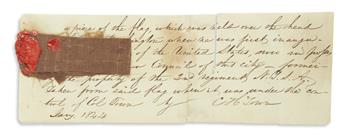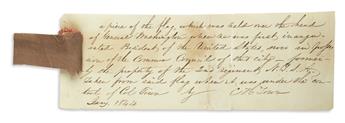Sale 2533 - Lot 256
Unsold
Estimate: $ 5,000 - $ 7,500
(WASHINGTON, GEORGE.) Piece of a banner said to have flown at Washington's inauguration. Swatch of fabric, 1 x 2 3/4 inches, red faded to brown, affixed with red sealing wax to a manuscript note by C.H. Town, 2 3/4 x 8 inches; separations at folds, tape repairs on verso. [New York], [1789-1844]
Additional Details
The note attached to this bit of silk reads "A piece of the flag which was held over the head of General Washington when he was first inaugurated President of the United States, now in the possession of the Common Council of this city, formerly the possession of the 2nd Regiment N.Y.S.A. Taken from said flag when it was under the control of Col. Town by C.H. Town, Jan'y 1844."
George Washington was inaugurated at Federal Hall in Manhattan on 30 April 1789. Both infantry regiments and an unspecified artillery unit accompanied the procession. The history of the New York militia units during this period is quite complex, but the regimental banner carried by that artillery regiment apparently descended to the Second Regiment of New York State Artillery over the following years.
The Second Artillery Regiment later came under the command of Charles Town (circa 1777-1858), a native of New Jersey who brought his family to Manhattan circa 1807. He was an auctioneer in the partnership of Hones & Town with Philip Hone, who later became famous as a mayor and diarist. Town also served as a board member of banks and insurance companies, and as a candidate for the city assembly in 1824. In 1818, he was named a major in the Second Regiment of the New York State Artillery, was promoted to colonel in 1819, and resigned in 1822, which gives us a fairly narrow window of when this flag sample would have been cut.
Colonel Town's son Charles H. Town (1807-1894) was the one who clipped this fragment from the banner under his father's stewardship between 1819 and 1821, when he would have been about 13 years old. This note was written in 1844 when he was 37 years old. The younger Charles was listed as a merchant in the 1850 census, never married, and settled in Staten Island after his father's death, where he lived with his unmarried brother and sister. He was buried in Greenwood Cemetery in Brooklyn.
Shortly after young C.H. Town took this souvenir, the 2nd New York State Artillery presented what remained of the inaugural banner to the city in an elaborate ceremony on 11 June 1821. Colonel Town's subordinate, Lieutenant Colonel Manley, made the presentation speech (and took over the regiment the following year). The flag was then, according to a later account, "deposited in a glass case in the Aldermanic Chamber, which proved to be its tomb for one hundred years." When next examined in 1921, it was found to be "a mere remnant of its former state, and showed nothing at all of its past brilliant color except at the staff where it was fastened, and there it was found to be a firm, heavy texture of silk and the color a rich red, the customary color of artillery flags." At that time, it was presented in another elaborate ceremony to the Metropolitan Museum of Art, "to be placed in the Armor Department . . . where it will receive the just honor due the only flag remaining used at Washington's inauguration." See Amelia Day Campbell, "The Last Washington Inaugural Flag," in Daughters of the American Revolution Magazine 55:10 (October 1921), pages 581-3, which includes a photograph of the banner as it then appeared.
We don't know where C.H. Town's piece of the banner spent the next hundred years, but the fragment and attached note were listed in the catalog of the famed autograph dealer Charles Hamilton in 1961, from whence they were purchased by Charles M. Williams (1912-1998) of Cincinnati for $75, and remained in his possession as late as 1979 according to correspondence included with this lot. They were acquired by the consignor at another auction house in 2013. With--a worn 19th-century engraving of the inauguration, 7 x 4 inches and 11 pages of provenance documentation dated 1961 to 2013.
George Washington was inaugurated at Federal Hall in Manhattan on 30 April 1789. Both infantry regiments and an unspecified artillery unit accompanied the procession. The history of the New York militia units during this period is quite complex, but the regimental banner carried by that artillery regiment apparently descended to the Second Regiment of New York State Artillery over the following years.
The Second Artillery Regiment later came under the command of Charles Town (circa 1777-1858), a native of New Jersey who brought his family to Manhattan circa 1807. He was an auctioneer in the partnership of Hones & Town with Philip Hone, who later became famous as a mayor and diarist. Town also served as a board member of banks and insurance companies, and as a candidate for the city assembly in 1824. In 1818, he was named a major in the Second Regiment of the New York State Artillery, was promoted to colonel in 1819, and resigned in 1822, which gives us a fairly narrow window of when this flag sample would have been cut.
Colonel Town's son Charles H. Town (1807-1894) was the one who clipped this fragment from the banner under his father's stewardship between 1819 and 1821, when he would have been about 13 years old. This note was written in 1844 when he was 37 years old. The younger Charles was listed as a merchant in the 1850 census, never married, and settled in Staten Island after his father's death, where he lived with his unmarried brother and sister. He was buried in Greenwood Cemetery in Brooklyn.
Shortly after young C.H. Town took this souvenir, the 2nd New York State Artillery presented what remained of the inaugural banner to the city in an elaborate ceremony on 11 June 1821. Colonel Town's subordinate, Lieutenant Colonel Manley, made the presentation speech (and took over the regiment the following year). The flag was then, according to a later account, "deposited in a glass case in the Aldermanic Chamber, which proved to be its tomb for one hundred years." When next examined in 1921, it was found to be "a mere remnant of its former state, and showed nothing at all of its past brilliant color except at the staff where it was fastened, and there it was found to be a firm, heavy texture of silk and the color a rich red, the customary color of artillery flags." At that time, it was presented in another elaborate ceremony to the Metropolitan Museum of Art, "to be placed in the Armor Department . . . where it will receive the just honor due the only flag remaining used at Washington's inauguration." See Amelia Day Campbell, "The Last Washington Inaugural Flag," in Daughters of the American Revolution Magazine 55:10 (October 1921), pages 581-3, which includes a photograph of the banner as it then appeared.
We don't know where C.H. Town's piece of the banner spent the next hundred years, but the fragment and attached note were listed in the catalog of the famed autograph dealer Charles Hamilton in 1961, from whence they were purchased by Charles M. Williams (1912-1998) of Cincinnati for $75, and remained in his possession as late as 1979 according to correspondence included with this lot. They were acquired by the consignor at another auction house in 2013. With--a worn 19th-century engraving of the inauguration, 7 x 4 inches and 11 pages of provenance documentation dated 1961 to 2013.
Exhibition Hours
Exhibition Hours
Aliquam vulputate ornare congue. Vestibulum maximus, libero in placerat faucibus, risus nisl molestie massa, ut maximus metus lectus vel lorem.






